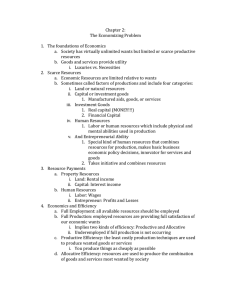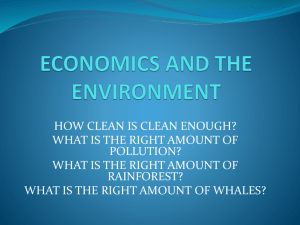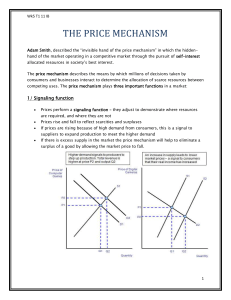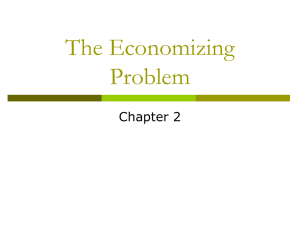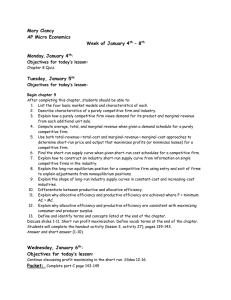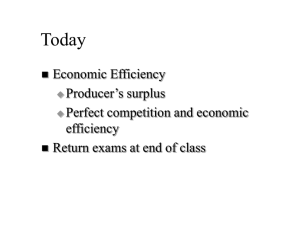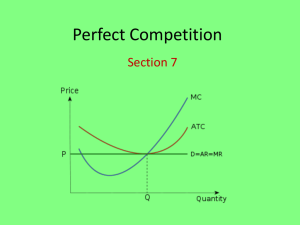File - LPS Business DEPT
advertisement
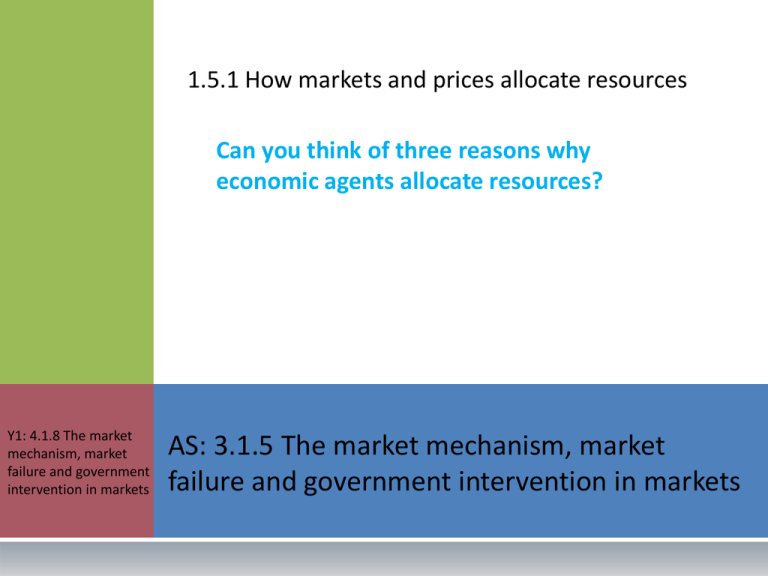
1.5.1 How markets and prices allocate resources Can you think of three reasons why economic agents allocate resources? Y1: 4.1.8 The market mechanism, market failure and government intervention in markets AS: 3.1.5 The market mechanism, market failure and government intervention in markets 1.5.1 H OW MARKETS AND PRICES ALLOCATE RESOURCES The rationing, incentive and signalling functions of prices in allocating resources and coordinating the decisions of buyers and sellers in a market economy The price mechanism is the way in which the basic economic problem is resolved in a market economy You should understand how economic incentives influence what, how and for whom goods and services are produced T HE RATIONING FUNCTION Excess demand for a good or service will lead to a rise in the price of a good or service This is due to the scarcity of the product The price rise will lead to a reduction in demand The more scarce a product the higher the price This leads to a rationing of the product as its use is restricted There will be a movement along the demand curve showing a decrease in quantity demanded and a decrease in price Draw a demand curve to show this T HE Contribution per unit of a product is the difference between the selling price of a product and the variable cost. The variable costs of a product are the costs that change as output increases e.g. the cost of the raw materials used to make a good. INCENTIVE FUNCTION Higher prices act as a motivator for producers to increase the supply of a good or service This is due to greater contribution per unit i.e. the difference between selling price and variable cost As prices rise so do revenue and profit There will be a movement along the supply curve showing an increase in quantity supplied Draw a supply curve to show this T HE SIGNALLING FUNCTION An increase in price will give an indication to producers that they should increase supply An increase in price will give an indication to consumers that they should reduce demand A decrease in price will give an indication to producers that they should decrease supply A decrease in price will give an indication to consumers that they should increase demand All of these signals will lead to shifts in the supply or demand curves T HE EFFECTIVENESS OF MARKETS IN ALLOCATING RESOURCES Efficiency is important for economists and there are a variety of efficiencies that come under the umbrella heading economic efficiency. Economic efficiency occurs when the maximum amount of products are produced at their minimum cost whilst maximising their benefit to society. Allocative efficiency occurs where consumer satisfaction is maximised in the production of goods and services At this point quantity supplied will equal quantity demanded Productive efficiency occurs when an economy uses the minimum inputs to produce the maximum output at lowest cost. Productive efficiency occurs where no additional (or maximum) output can be produced from the factor inputs available at the lowest possible average or unit cost Allocative efficiency occurs when society is producing goods to match the needs of consumers. Economic efficiency occurs where we have allocative and productive efficiency at the same time Both productive and allocative efficiency can be illustrated using a PPF T HE EFFECTIVENESS OF MARKETS IN ALLOCATING RESOURCES Recap. What does the PPF show? Allocative efficiency takes into account the desires of consumers. If good Y is in greater demand than good X then production at point A will be more allocatively efficient than that of point B. Therefore, allocative efficiency can be found somewhere on the PPF but at what point depends upon consumer preference. Good Y • A • B Good X T HE EFFECTIVENESS OF MARKETS IN ALLOCATING RESOURCES What is the cause and effect of reallocating resources at Cisco? Allocative efficiency is difficult to identify as we need to match consumer preferences to producer output Put another way, we need to match demand and supply As seen in the unit on equilibrium price markets do not always operate at the market clearing price due to: Excess supply (S>D) Excess demand (D>S) Market forces do push prices towards equilibrium where quantity demanded will equal quantity supplied Therefore, it is likely that competitive markets help in achieving allocative efficiency T HE PRICE MECHANISM IS THE WAY IN WHICH THE BASIC ECONOMIC PROBLEM IS RESOLVED IN A MARKET ECONOMY In diagram A current output of apples is Q2, above the equilibrium price. In diagram B current output of pears is Q2, below the equilibrium price. Price A S B Price S P2 P1 P1 P2 D D In both markets we have allocative inefficiency. 0 By reallocating resources from the production of apples to that of pears we can increase allocative efficiency. If apples were produced at Q1 and pears were produced at Q1 we have allocative efficiency. Q1 Q2 Quantity 0 Q2 Q1 Quantity Apples and pears In diagram A suppose the market price is P2. Consumers value the last unit produced at Q1, where price is P1. However, firms produce at Q2. In diagram B suppose the market price is P2. Consumers value the last unit produced at Q1, where price is P1. However, firms produce at Q2. Consumers are not willing to pay the higher price so price will fall and firms will reduce supply. Consumers are willing to pay the higher price so price will rise to P2 and firms will increase supply. This might lead to a reallocation of a firms’ resources to another use e.g. from apples to pears. This might lead to a reallocation of a firms’ resources from another use e.g. from apples to pears. T EST Define the term allocative efficiency. YOURSELF For a number of years the supply of organic produce grew at a rate just enough to meet its demand. In the recession consumers started to cut back on organic produce but supply continued to increase at the same rate. 1. Explain whether the market for organic produce is working efficiently. 2. In the diagram below the price of a product is P2 and output is Q2. Explain why this combination of price and output is allocatively inefficient. S Price P2 P1 D 0 Q1 Q2 Quantity Q UICK TEST Society prefers good X to good Y. At which point(s) is the business operative at allocative efficiency? Good Y • D • A • C • B a) A and B b) C only c) D only d) B only Can you explain your answer? Good X
